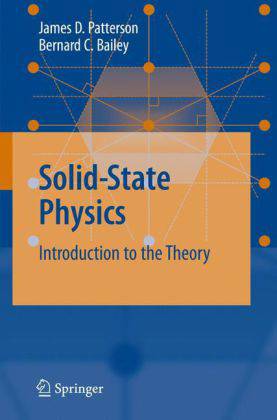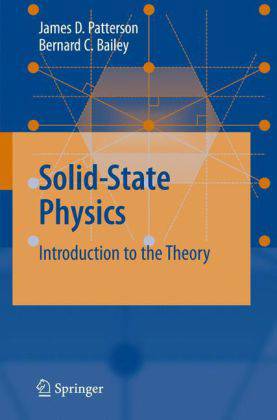
En raison d'une grêve chez bpost, votre commande pourrait être retardée. Vous avez besoin d’un livre rapidement ? Nos magasins vous accueillent à bras ouverts !
- Retrait gratuit dans votre magasin Club
- 7.000.000 titres dans notre catalogue
- Payer en toute sécurité
- Toujours un magasin près de chez vous
En raison de la grêve chez bpost, votre commande pourrait être retardée. Vous avez besoin d’un livre rapidement ? Nos magasins vous accueillent à bras ouverts !
- Retrait gratuit dans votre magasin Club
- 7.000.0000 titres dans notre catalogue
- Payer en toute sécurité
- Toujours un magasin près de chez vous
Solid-State Physics
Introduction to the Theory
James Patterson, Bernard Bailey
Livre broché | Anglais
105,45 €
+ 210 points
Format
Description
While the standard solid state topics are covered, the basic ones often have more detailed derivations than is customary (with an empasis on crystalline solids).
Several recent topics are introduced, as are some subjects normally included only in condensed matter physics. Lattice vibrations, electrons, interactions, and spin effects (mostly in magnetism) are discussed the most comprehensively.
Many problems are included whose level is from "fill in the steps" to long and challenging, and the text is equipped with references and several comments about experiments with figures and tables. Learning Solid State Physics involves a certain degree of maturity, since it involves tying together diverse concepts from many areas of physics. The objective is to understand, in a basic way, how solid materials behave. To do this one needs both a good physical and mathematical background. One definition of Solid State Physics is it is the study of the physical (e.g. the electrical, dielectric, magnetic, elastic, and thermal) properties of solids in terms of basic physical laws. In one sense, Solid State Physics is more like chemistry than some other branches of physics because it focuses on common properties of large classes of materials. It is typical that Solid State Physics emphasizes how physics properties link to electronic structure. We have retained the term Solid State Physics, even though Condensed Matter Physics is more commonly used. Condensed Matter Physics includes liquids and non-crystalline solids such as glass, which we shall not discuss in detail. Modern Solid State Physics came of age in the late thirties and forties, and had its most extensive expansion with the development of the transistor, integrated circuits, and microelectronics. Most of microelectronics however is limited to the properties of inhomogeneously doped semiconductors. Solid State Physics includes many other areas of course; among the largest of these are ferromagnetic materials, and superconductors. Just a little less than half of all working physicists are in Condensed Matter.
A course in Solid State Physics typically begins with three broad areas: (1) How and why atoms bind together to form solids, (2) Lattice Vibrations and Phonons, and (3) Electrons in Solids. One would then typically apply the above to (4) Interactions especially of electrons with phonons, (5) Metals, the Fermi Surface and Alloys, (6) Semiconductors, (7) Magnetism, (8) Superconductivity, (9) Dielectrics and Ferroelectrics, (10) Optical Properties, (11) Defects, and (12) Certain other modern topics such as layered materials, quantum Hall effect, mesoscopics, nanophysics, and soft condensed matter. In this book, we will consider all of these.
Several recent topics are introduced, as are some subjects normally included only in condensed matter physics. Lattice vibrations, electrons, interactions, and spin effects (mostly in magnetism) are discussed the most comprehensively.
Many problems are included whose level is from "fill in the steps" to long and challenging, and the text is equipped with references and several comments about experiments with figures and tables. Learning Solid State Physics involves a certain degree of maturity, since it involves tying together diverse concepts from many areas of physics. The objective is to understand, in a basic way, how solid materials behave. To do this one needs both a good physical and mathematical background. One definition of Solid State Physics is it is the study of the physical (e.g. the electrical, dielectric, magnetic, elastic, and thermal) properties of solids in terms of basic physical laws. In one sense, Solid State Physics is more like chemistry than some other branches of physics because it focuses on common properties of large classes of materials. It is typical that Solid State Physics emphasizes how physics properties link to electronic structure. We have retained the term Solid State Physics, even though Condensed Matter Physics is more commonly used. Condensed Matter Physics includes liquids and non-crystalline solids such as glass, which we shall not discuss in detail. Modern Solid State Physics came of age in the late thirties and forties, and had its most extensive expansion with the development of the transistor, integrated circuits, and microelectronics. Most of microelectronics however is limited to the properties of inhomogeneously doped semiconductors. Solid State Physics includes many other areas of course; among the largest of these are ferromagnetic materials, and superconductors. Just a little less than half of all working physicists are in Condensed Matter.
A course in Solid State Physics typically begins with three broad areas: (1) How and why atoms bind together to form solids, (2) Lattice Vibrations and Phonons, and (3) Electrons in Solids. One would then typically apply the above to (4) Interactions especially of electrons with phonons, (5) Metals, the Fermi Surface and Alloys, (6) Semiconductors, (7) Magnetism, (8) Superconductivity, (9) Dielectrics and Ferroelectrics, (10) Optical Properties, (11) Defects, and (12) Certain other modern topics such as layered materials, quantum Hall effect, mesoscopics, nanophysics, and soft condensed matter. In this book, we will consider all of these.
Spécifications
Parties prenantes
- Auteur(s) :
- Editeur:
Contenu
- Nombre de pages :
- 717
- Langue:
- Anglais
Caractéristiques
- EAN:
- 9783642063244
- Format:
- Livre broché
- Dimensions :
- 156 mm x 235 mm
- Poids :
- 1095 g

Les avis
Nous publions uniquement les avis qui respectent les conditions requises. Consultez nos conditions pour les avis.






